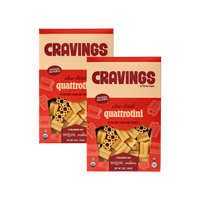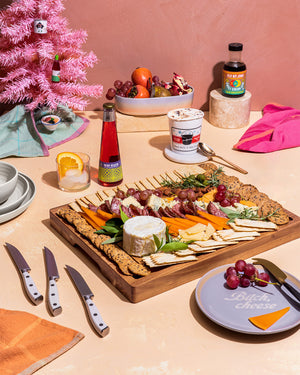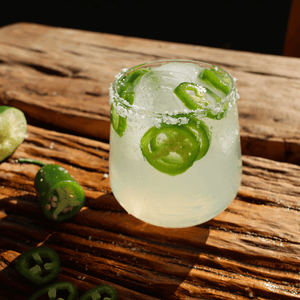Vitamin C should really just stand for Vitamin Citrus. As we go on, remember that one of the most delicious ways to make sure your immune system is in tip-top shape is to add a lot more citrus fruits into your life—and not just lemons and limes. Citrus season runs from December to April, and there are so many different types of citrus you can use for drinks, dressings, marinades, baking, and more. We tapped our friends at Frog Hollow Farm in Brentwood, CA—who sell dozens of varietals of citrus—to get to know six underrated types of citrus you should try this season. Find out how to pick out the best fruit, what to make with them, and how to store everything for peak freshness.
How to Pick Out Citrus at the Store or Market
Look for:
-
Vibrant colors (tinges of green on oranges and lemons are okay, as they’ll keep a little longer. But it also might mean they’re underripe)
-
Strong, sweet smell
-
Heaviness (if it's heavier than fruits around it, it’s juicer!)
-
Finely textured peel versus a thick, dimpled peel
-
Mandarins, tangerines, and clementines should have a looser peel, but other citrus varieties should have firm peels
Avoid:
-
Shriveled/wrinkled skin
-
Mold or blemishes
-
Squishy or soft, tender spots
How to Store Citrus
On the counter: Citrus will keep up to a week uncovered at room temperature (depending on how hot your home is, of course). Room temp citrus tends to taste a little sweeter, and it’s right where you can see it. A nice reminder to eat it ASAP!
In the fridge: If you’re not going to eat your citrus right away, you can store most types for a couple of weeks in the crisper/vegetable drawer of your fridge. With lemons and limes, though, it’s best to put them in a plastic bag or wrap them before putting them in the fridge, as they will dry out otherwise. (They typically last up to 5 days.) Whether on the counter or in the fridge, keep them dry to prevent molding.
In the freezer: You can freeze citrus in wedges or slices, zested, juiced, or whole for up to a couple months; after that they get bitter. If you’re freezing them whole, put them in a freezer bag and remove as much air as possible when you seal. To freeze slices, lay them out on a sheet pan in the freezer for a few hours. Once they’re a bit solid, they’ll be easier to put into a freezer bag.
Get to Know Your Citrus

1. Yuzu

-
What is yuzu? Yuzu is a unique hybrid of a rare citrus called Ichang papeda and a sour mandarin orange. It is incredibly fragrant (an aroma of lime, lemon, and grapefruit) with a less sharp and more subtle flavor than lemon.
-
What is it best for making? You can make or buy a spicy Japanese condiment called yuzu kosho with fermented chiles, salt, and yuzu juice and zest. Or use it in cocktails, juices, marinades, sauces, and dressings—it's more savory than sweet but it works for both uses.
2. Blood Orange

-
What is a blood orange? An orange with vivid tartness and color. The color deepens as the season progresses into the spring, and they have a firmer, more dense flesh than a typical orange.
-
What is it best for making? Colorful salads (especially with subtle flavors like avocado and bitter ones like radicchio and licorice-y fennel), baked goods, and cocktails. Use blood oranges any place you would use oranges, but want a little more dramatic color and pucker-up flavor.
3. Buddha's Hand

-
What is Buddha's Hand? This funky-looking fruit looks like a hand made of long lemon fingers...but don't be afraid! The hybrid fruit actually has little to no flesh and no seeds, so you can use the rind for cooking, baking, and drinks. It's also very fragrant and smells faintly of lavender.
-
What is it best for making? Use the zest for cocktails, candied fruit, marmalades, dressings, and substituting for other citrus in baked goods or breakfast foods like waffles.
4. Rio Red Grapefruit

-
What is a Rio Red Grapefruit? This type of grapefruit is more sweet than tart but not TOO sweet. The subtle sweetness, eye-catching red color, and insane juiciness will make this your favorite grapefruit. Plus, they're seedless for easy eating or juicing.
-
What is it best for making? Many salads can be improved by a Rio Red-spiked dressing, but especially if mellow avocado is involved. Try mixing into cakes, making compotes, or just eating for breakfast—no sugar needed.
5. Meyer Lemon

-
What is a Meyer Lemon? A cross between a citron and a mandarin, Meyer Lemons are sweeter and more fragrant than your typical lemon. They’re less acidic and less bitter, too, making them ideal for lemonade.
-
What is it best for making? There's very little you can't do with a Meyer Lemon! Try it in drinks, pies, marmalades, pastas, and with seafood or roasted meats.
6. Satsuma Mandarin

-
What is a Satsuma Mandarin? Satsumas are one of the sweetest varieties of citrus out there. They’re easy to peel, usually seedless, and have a significant amount of Vitamin C. Once you have one, you'll want to eat a dozen.
-
What is it best for making? TBH, just eating out of hand! You can also cover in chocolate, add to a salad, or pair with roasted asparagus or other tender-crisp relatively mild vegetables.
All images courtesy of Frog Hollow Farm.












